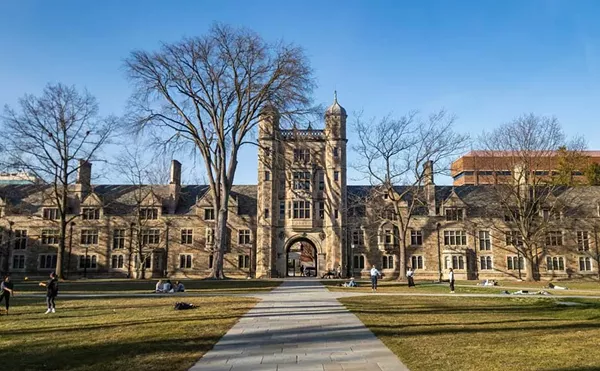The perfect storm — and we mean it in a good way — of Mayor Dave Bing's renewed emphasis on redesigning Detroit, the state's new Complete Streets legislation, and a grassroots movement toward increasing the safety of and opportunities for nonmotorized transportation has Miguel Pope cautiously excited.
Pope, who lives near Belle Isle and is a consultant doing life coaching and motivational speaking, rides his bike nearly daily to his downtown Detroit office. To get to the central city, he's got options: he can pedal north through his neighborhood and then southwest with the traffic along Gratiot Avenue or he can detour across Jefferson Avenue until he can get on the Detroit RiverWalk greenway that provides him a (mostly) exclusive, nonmotorized path from Mount Elliott to downtown.
"If I'm riding trying to get somewhere, I want a straight route. If I'm riding more for leisure, I want the scenery," he says.
Pope was among several dozen people who attended two workshops last week to help formulate the plan for more nonmotorized routes in the city's lower east side neighborhoods. With a relatively high concentration of housing between Belle Isle and the Grosse Pointe Park border, the area is a juicy target for the greenway planners who have private grant money to design the system. The eventual construction funds will come from city, state and federal coffers after plans are designed and submitted.
And how those routes will eventually wind along the riverfront, through neighborhoods and perhaps on vacant land will be determined by input from people like Pope, a host of planners and city administrators. They could be built on exclusive pathways like the RiverWalk. They could be marked routes along neighborhood streets or they could be new paths traversing parks.
Whatever they end up being, they could be a highlight of a redesigned Detroit.
"They're critically important," says Tom Woiwode, the greenways guru at the Community Foundation of Southeast Michigan who also sits on Bing's 55-member Detroit Works advisory committee. "I think it's becoming increasingly clear that the citizenry wants those kinds of pedestrian and nonmotorized opportunities. I would imagine that the plans that come out of the Detroit Works process will very actively and very aggressively embrace nonmotorized transportation.
Regardless, the nonmotorized revolution has already begun and we don't just mean the record-setting 3,200 cyclists who rode the Tour de Troit last weekend. Construction continues on the Midtown Loop, a recreational if not effective commuter route through the neighborhoods near Wayne State University and the Cultural Center. Meanwhile, the Corktown-Mexicantown Greenlink system is under way, and Detroit city officials are working on a Complete Streets policy that would conform with the state law enacted earlier this year.
The Complete Streets idea is that roadways be constructed — or at least maintained, re-designed or re-constructed when possible — for a multitude of users, not just automobiles and trucks. Any motorist now trying to speed down Anthony Wayne Drive on the western side of Wayne State's campus, will see the mind-set in action.
The university, working with the city and the state, is reducing the four traffic lanes in each direction to two, adding parking along the curbs, adding bicycle lanes next to the parking, and installing more marked pedestrian crossings along the several-block-long stretch.
"By reducing the number of lanes, we'll also see a reduction in travel speeds through that section," says Peter Savolainen, an assistant professor of civil and environmental engineering and part of the university's Transportation Research Group. "We're trying to make the road safer for bicycles and pedestrians."
The city's Department of Health and Wellness Promotion is working on a formal Complete Streets ordinance for City Council to adopt — possibly by early next year, says Michael McElrath II, the spokesperson for the Detroit Department of Health and Wellness Promotion.
Along Michigan Avenue west of downtown, bike lanes should be painted by November as a "trial," says Matt Chynoweth, a development engineer with the Michigan Department of Transportation's Detroit Transportation Service Center.
"We're going to evaluate for a year and if we have a spike in pedestrian accidents out there then we may have to evaluate it and take it out," he says.
Bike lanes are an easy way to increase safety by helping motorists realize cyclists are nearby. And some planners say they could be introduced all over the city for little more than the cost of the paint.
"We generally know what we want to try and achieve," says Cheryl Zuellig, a senior landscape architect with JJR, an Ann Arbor-based firm involved in the greenway planning. "It makes sense to think about and keep in mind some of the redevelopment plans in the city and how they can be combined with the greenways. Those two things will go hand in hand as we look to the future."
News Hits is edited by Curt Guyette. Contact him at 313-202-8004 or [email protected]





